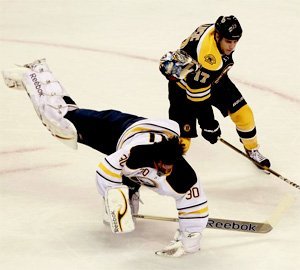
In the wake of the recent collision between Bruins’ winger Milan Lucic and Sabres’ goaltender Ryan Miller, in which Lucic escaped a suspension while Miller remains out with a concussion, many among the Maple Leafs‘ fanbase were quick to recall the October 22nd collision between Canadiens’ winger Brian Gionta and Leafs‘ goaltender James Reimer.
Although the temptation to directly compare the two incidents is understandable (player colliding with goaltender attempting to make a play, goaltender sustains a head injury, player is not suspended), they are in fact two quite different incidents subject to different sets of rules.
Through the course of examining these two incidents, and the reasons for a lack of supplementary discipline in light of the NHL rulebook, we stumble upon a significant debate: does the current iteration of the NHL’s illegal contact rules do more to protect goaltenders, or to hinder them?
Before we can get into the examples of the Miller and Reimer collisions, let’s take a look at the NHL Rulebook, specifically Rules 42 and 48. I’ll limit this discussion to the context of these two rules in particular, as they happen to apply directly to the examples below.
—–
Via NHL.com:
Rule 42 – Charging
42.1 Charging – A minor or major penalty shall be imposed on a player who skates or jumps into, or charges an opponent in any manner.
Charging shall mean the actions of a player who, as a result of distance traveled, shall violently check an opponent in any manner. A charge may be the result of a check into the boards, into the goal frame or in open ice.
A minor, major or a major and a game misconduct shall be imposed on a player who charges a goalkeeper while the goalkeeper is within his goal crease.
A goalkeeper is not fair game just because he is outside the goal crease area. The appropriate penalty should be assessed in every case where an opposing player makes unnecessary contact with a goalkeeper. However, incidental contact, at the discretion of the Referee, will be permitted when the goalkeeper is in the act of playing the puck outside his goal crease provided the attacking player has made a reasonable effort to avoid such contact.
42.2 Minor Penalty – The Referee, at his discretion, may assess a minor penalty, based on the degree of violence of the check, to a player guilty of charging an opponent.
42.3 Major Penalty — The Referee, at his discretion, may assess a major penalty, based on the degree of violence of the check, to a player guilty of charging an opponent (see 42.5).
42.4 Match Penalty — The Referee, at his discretion, may assess a match penalty if, in his judgment, the player attempted to or deliberately injured his opponent by charging.
42.5 Game Misconduct Penalty – When a major penalty is imposed under this rule for a foul resulting in an injury to the face or head of an opponent, a game misconduct shall be imposed.
42.6 Fines and Suspensions — When a major penalty and a game misconduct is assessed for a foul resulting in an injury to the face or head of an opponent, an automatic fine of one hundred dollars ($100) shall be imposed.
If deemed appropriate, supplementary discipline can be applied by the Commissioner at his discretion (refer to Rule 28).
—
Rule 48 – Illegal Check to the Head
48.1 Illegal Check to the Head — A hit resulting in contact with an opponent’s head where the head is targeted and the principal point of contact is not permitted. However, in determining whether such a hit should have been permitted, the circumstances of the hit, including whether the opponent put himself in a vulnerable position immediately prior to or simultaneously with the hit or the head contact on an otherwise legal body check was avoidable, can be considered.
48.2 Minor Penalty – For violation of this rule, a minor penalty shall be assessed.
48.3 Major Penalty – There is no provision for a major penalty for this rule.
48.4 Game Misconduct Penalty — There is no provision for a major penalty for this rule.
48.5 Match Penalty – The Referee, at his discretion, may assess a match penalty if, in his judgment, the player attempted to or deliberately injured his opponent with an illegal check to the head.
48.6 Fines and Suspensions — Any player who incurs a total of two (2) game misconducts under this rule, in either regular League or playoff games, shall be suspended automatically for the next game his team plays. For each subsequent game misconduct penalty the automatic suspension shall be increased by one game.
If deemed appropriate, supplementary discipline can be applied by the Commissioner at his discretion (refer to Rule 28).
—–
Lengthy, I know, but important to the discussion at hand.
The most prevalent aspect of Rule 42 is section 42.1, specifically the latter paragraph:
“A goalkeeper is not fair game just because he is outside the goal crease area. The appropriate penalty should be assessed in every case where an opposing player makes unnecessary contact with a goalkeeper. However, incidental contact, at the discretion of the Referee, will be permitted when the goalkeeper is in the act of playing the puck outside his goal crease provided the attacking player has made a reasonable effort to avoid such contact.“
This rule seems to effectively double-back on itself by saying goaltenders are not fair game outside the crease … unless they happen to be playing the puck … in which case players should still be penalized for running into them anyway … unless the contact was deemed unavoidable.
Does anyone else see the potential for some serious interpretation problems?
Rule 48 is equally problematic when applied to goaltenders, who by the very nature of limited space in which to move are in a vulnerable position whenever the opponent crowds the net. This is particularly of concern when followed by the notion of “an otherwise legal body check” … which Rule 42 suggests isn’t the case unless the goaltender happens to be playing the puck and the player was deemed by the referees to have done all he could to avoid contact.
Compounding the issue is the lack of any specific mention of goaltenders in Rule 48. If the goaltender puts himself in a vulnerable position by virtue of the very nature of his job, can the rule be fairly applied in the first place, or does it leave itself open to the same interpretation difficulties as the aforementioned Rule 42?
You may be asking at this point where Rule 69 (Interference on the Goalkeeper) comes into play. Rule 69 governs primarily interference on scoring plays and circumstances in which goals are to be allowed or disallowed. The exception is 69.2 which details when a minor penalty for interference is to be assessed, independent of whether a goal was or was not scored on the play.
Aside: A significant overlap issue does potentially exist with Rule 69. If a player were to charge a goaltender outside the crease — similar to Lucic — but the play resulted in a goal, would Rule 69 still apply? Or would it be Rule 42, which explicitly makes certain concessions for goaltenders? Or a combination of both, in which case where do the lines cross? Compounding the issue is Rule 69 does not at all address the headshot issue, leading to the potential for another overlap issue with Rule 48.
We can illustrate the conundrum created by the application of these rules as currently written to goaltenders, by examining the hits on Miller and Reimer.
LUCIC – MILLER
As the puck enters the zone, Miller leaves his crease to play the puck while Lucic is chasing after it full-throttle. Because he is playing the puck, Miller is fair game for contact … so long as Lucic makes a reasonable effort to avoid said contact as stated in Rule 42. The window between Miller playing the puck and Lucic colliding into him is roughly one second (occurs between the 4-5 second mark of the video). Pay attention to how Lucic is able to stop moving his legs the moment Miller beats him to the puck, as opposed to continuing to propel himself toward the goaltender. Also take note of how Lucic makes no effort to get out of the way beyond transitioning from ‘stride’ to ‘glide’ … and therein lies the problem.
In this circumstance, a case could certainly be made for the play to violate Rule 42 (Charging), and possibly Rule 48 (Illegal Check to the Head) also. But neither scenario would be without its challenges.
Does the fact that Lucic made an effort to slow down prior to contact as opposed to railroading Miller at top speed qualify as “reasonable effort to avoid contact”, and thus negate disciplinary measures under Rule 42? In other words, does an attempt to lessen the force of impending contact satisfy the reasonable effort clause, in the context of a window of less than two seconds? It’s not an easy question to answer.
Equally difficult to answer are the questions raised by Rule 48. Lucic made direct contact with Miller’s head causing injury, yet the goaltender put himself in a vulnerable position by venturing out of his crease to race Lucic to the puck. Due to the short window of time between Miller winning the race to the puck and Lucic crashing into him, it is difficult to ascertain if Lucic actively targeted the head (illegal), or simply couldn’t avoid Miller, rendering the contact incidental (technically legal as Miller was playing the puck).
Evidently, the ‘too small a window’ line of reasoning ultimately won over league disciplinarian Brendan Shanahan, as no suspension was assessed. Said Shanahan:
“I had the hearing because I did make an initial assessment of the play as I do with all plays, but I did have some questions for [Lucic] and I wanted to hear directly from him. They were regarding his intent; at what point did he know there was going to be a collision; and whether or not he felt he had the time to avoid the collision. I was satisfied with his answers.”
GIONTA – REIMER
Naturally, the first instinct among a large contingent of Leafs‘ fans was to recall the collision between Brian Gionta and James Reimer. I suggested earlier this hit shares less in common with the Lucic-Miller incident than many believe, and viewing both videos back-to-back reaffirms this to be the case.
With the Canadiens in possession of the puck, Gionta makes a beeline from the area below the faceoff circle toward the top of the crease. At the moment he arrives, Leafs‘ defender Dion Phaneuf is driven toward the net by Tomas Plekanec causing Gionta — in motion but facing away from Reimer — to run out of space and clip the goaltender as he loses his balance.
Following Rule 42, the play does not satisfy the requirement of a ‘charging’ penalty. There is little evidence to suggest Gionta targeted Reimer directly as he was clearly eyeing the puck further up the zone (unlike Lucic who was looking directly at Miller), and once at the top of the crease could do little to avoid contact with the goaltender to whom his back was turned. Thus, Rule 42 would not apply in this circumstance.
Similarly, the hit does not satisfy Rule 48 either. The fact of the matter is goaltenders put themselves in vulnerable positions due to the nature of their job (traffic in the crease, etc), and the rule makes no exception for their doing so. Further, one can argue that although the head was the principle point of contact, that contact was incidental by virtue of Gionta having his back turned to Reimer and the ‘push back’ effect of the battle between Plekanec and Phaneuf.
At the end of the day, the call of ‘goaltender interference’ under Rule 69 was the right one within the context of the rulebook despite the resultant injury to Reimer. But just as suspension does not always equate to injury, injury does not always equate to suspension. To his credit, Reimer — along with several of his teammates — were quick to suggest it was an incidental play which did not deserve further punishment.
Time For (Yet) Another Rule Change?
It has long been assumed to be an unwritten rule among players that the goaltender is not to be hit. Yet what we have seen in the two incidents above is goaltenders subject to serious injury via direct contact to the head, with the rules governing those plays providing little deterrence prior to, or in the aftermath of, either incident. Does some form of rule need to be explicitly written for player-goaltender contact, beyond the discretionary vagueness exemplified in Rule 42?
For example, in the case of Reimer the key issue is the space in which the goaltender has a right to operate. While no one wants to see the return of the maligned crease violation rule, no one wants to see the goaltender take a shot to the head either, inadvertent or not. Contrast that to the scenario with Miller, where the issue is the goaltender’s ability to play the puck outside the crease. The current rules, as illustrated by the scenarios above, leave open the possibility (especially in the Lucic-Miller circumstance) for players to exploit a what appears to be a series of loopholes allowing them to make a significant degree of contact with the goaltender without fear of reprisal.
What is made evident by cases such as those illustrated above is a disconnect between the rules designed to distinguish illegal from incidental contact and the reality of their application to goaltenders. It is certainly true that all contact is not made equal; factor in a position with completely different motion requirements and limitations, and a set of rules designed to blanket everyone, and we have a recipe for inconsistency among those officiating the game and confusion those playing it.
At the crux of the issue is the reality that not all contact can be easily or clearly defined as ‘incidental’ or ‘illegal’; significant grey areas do exist between ‘reasonable’ and ‘intentional’, between ‘vulnerable’ and ‘targeted’, and in the relationship between the various rules that come into play. Already an area of concern with player-on-player contact, this issue is magnified exponentially when those same rules are applied to players making contact with goaltenders, due to the unique nature of the position and the limited ability a goaltender has to reasonably protect himself. The blanket approach of the rulebook, quite simply, appears to have created the potential for more problems than solutions under this scenario.
Questions that arise include, but are by no means limited to:
- Should player-goaltender contact be subject to the same rules as player-player contact?
- Could the league better protect its goaltenders by further specifying vague or interpretation-based rule phrasing, such as what constitutes “a reasonable effort to avoid contact” in 42.1, or “a vulnerable position” in 48.1? The current rules, which leave those determinations to the referee’s discretion, open the door to inconsistent interpretation and application of minor vs major and/or misconduct penalties. This creates the potential for the delivery of mixed messages regarding the exact nature, and limits, of the rules to the players and coaches.
- Should player-to-goaltender contact be addressed in a separate or sub-section under each rule? Considering how goaltenders are more likely to be at or near a standstill when hit, while players are typically in motion; consider also the limited space in which goaltenders operate. Lending credence to this argument is the reality that goaltenders do not generally practice contact drills and are certainly not accustomed to having to absorb full body contact. (Author’s note: Personally, I lean toward accounting for and further fleshing-out those differences in a separate section within each rule — e.g. 48.1(b) Illegal Check to the Head, Goaltenders — as a possible improvement given the unique nature of player-goaltender contact.)
- Does Ron Wilson’s suggestion of increasing goaltender protection akin to quarterbacks in football have merit given their importance to the team, and with most clubs typically carrying only two on an active roster?
- Or should we be content to accept the rules will always to be subject to ‘shades-of-grey’ situations such as the Lucic-Miller collision by the high-speed nature of the game itself?
It’s a terrific debate, with valid arguments existing on all sides. Where do you come out on the application of rules such as 42 and 48 (among others) to the Gionta-Reimer and Lucic-Miller situations, and to goaltending in general?
Update:
@DarrenDreger GM’s discuss goalie protection at mtng. Message back to players…goalies are not free game, but no rule amendment is necessary.
In other words, we should expect this situation to continue to rear its ugly head as the season progresses.
Looking forward to your thoughts as always,
garrettbauman@www.mapleleafshotstove.com
twitter.com/garrettbauman


![Sheldon Keefe on the Maple Leafs’ struggling power play: “[We’ve scored] one out of 11 high-danger chances in tight to the net… We have been in those spots and haven’t converted” Sheldon Keefe, playoff press conference](https://mapleleafshotstove.com/wp-content/uploads/2024/04/keefe-pc-game-3-218x150.jpg)
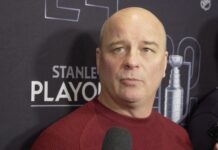
![Jim Montgomery Post Game, Bruins 4 vs. Leafs 2: “[Marchand] still manages to get under people’s skin, yet he doesn’t cross the line” Jim Montgomery, Boston Bruins post game](https://mapleleafshotstove.com/wp-content/uploads/2024/04/jim-monty-pg-to-218x150.jpg)
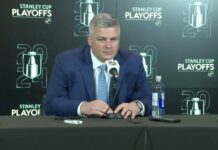




















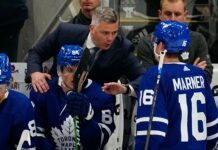


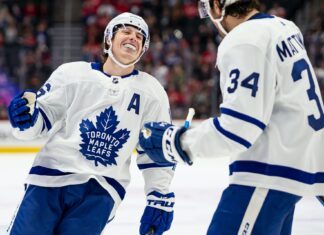

![Sheldon Keefe on the Maple Leafs’ struggling power play: “[We’ve scored] one out of 11 high-danger chances in tight to the net… We have been in those spots and haven’t converted” Sheldon Keefe, playoff press conference](https://mapleleafshotstove.com/wp-content/uploads/2024/04/keefe-pc-game-3-100x70.jpg)



![Jim Montgomery Post Game, Bruins 4 vs. Leafs 2: “[Marchand] still manages to get under people’s skin, yet he doesn’t cross the line” Jim Montgomery, Boston Bruins post game](https://mapleleafshotstove.com/wp-content/uploads/2024/04/jim-monty-pg-to-100x70.jpg)

